-
1 of 253523 objects
Urn representing Spring 1704
Lead and antimony alloy, marble, stone | 135 x 86 x 86 cm (whole object) | RCIN 71437
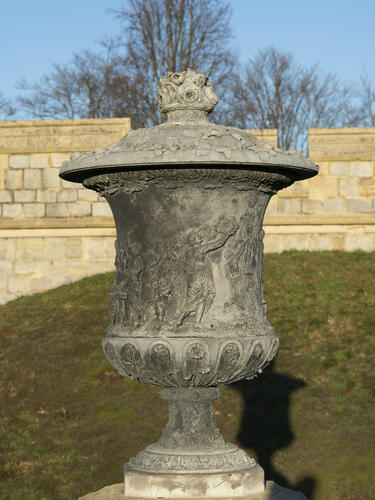
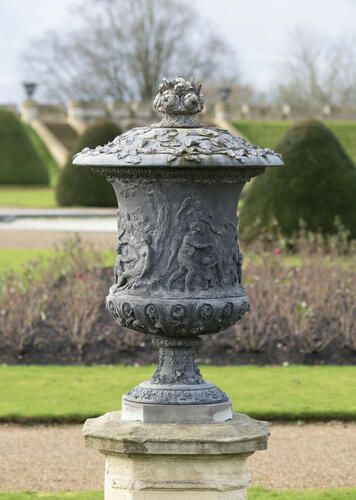
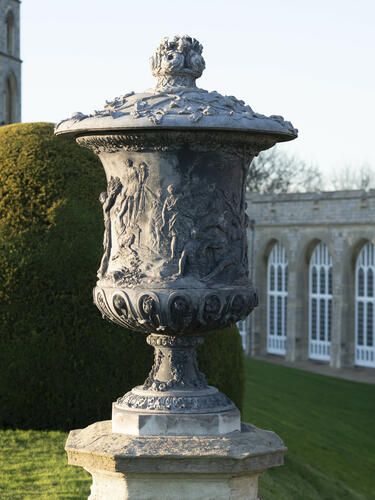
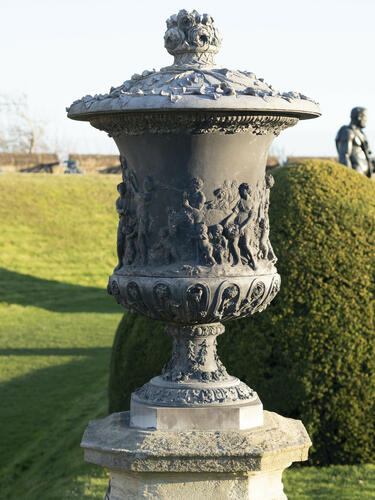
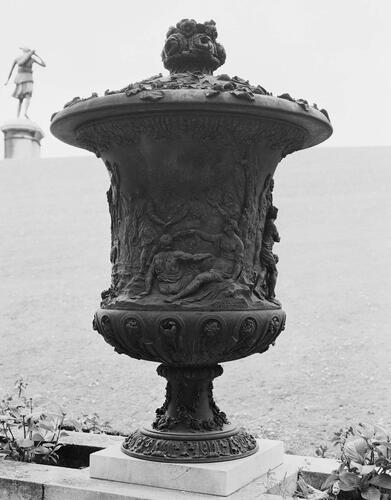
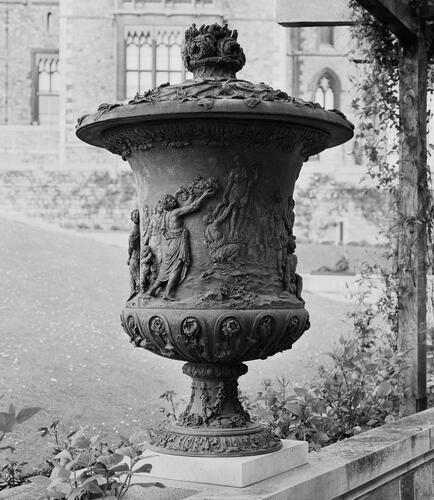
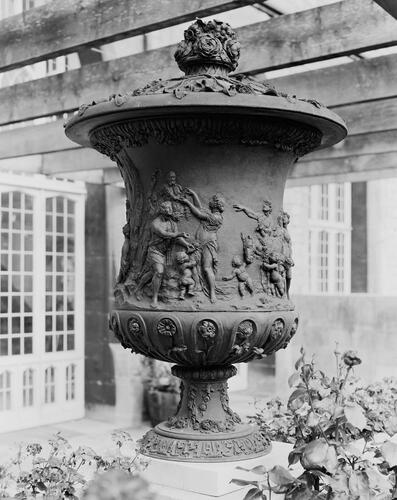
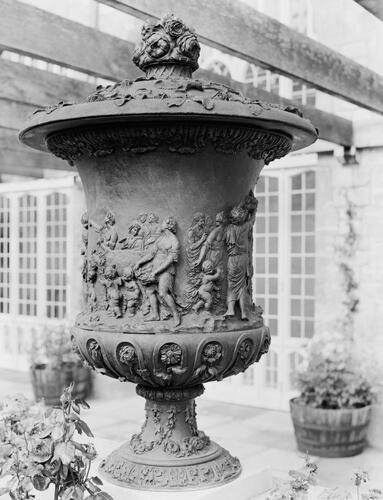
-
A lead alloy urn with a decorative finial, overhanging lid, tall body with a continuous figurative frieze in relief, a broad bowl, tall stem and spreading foot, representing Spring. One of four urns depicting the Four Seasons. The friezes were modelled by Willem van Mieris (1662–1747); the ornaments of the feet and lids were modelled by Giovanni Battista Lurago (before 1675–1736); and the urns were cast by Filips van der Mij (1654–1721).
The frieze modelled with nymphs, satyrs and others among trees. Some are offering garlands to a term of Priapus, while others approach a statue of Flora, bearing gifts. The finial is modelled as a basket full of varied flower-heads and foliage in relief trailing over the lid. The bowl with hollow gadroons, each filled by a flowering stem of rose, tulip and other flowers. The stem is garlanded with flowers while the foot and upper border of the body are bordered with continuous acanthus foliage. Cast inscription on a rock in the lower part of the frieze: W VAN MIERIS / INV. ET FECIT / MDCCIV.
These magnificent vases are the result of a happy conjunction of two modellers and a founder of great skill, and an enlightened, wealthy and patient patron. In conception and execution they have few rivals in this branch of art, and after more than three centuries in the open air they remain in a near-perfect state.
The vases were commissioned by the successful cloth merchant Pieter de la Court van der Voort (1664–1739) for the garden of the house which he bought in Leiden in 1700. A keen amateur of painting (he commissioned 85 works from living artists – including Willem van Mieris – and possessed a further 130) and gardening, he travelled to France in 1700, visiting the Louvre, Marly, Versailles, Meudon and Saint-Cloud. On his travels he had ample opportunity to study the sculpture of Louis XIV’s gardens, including the great vases created by Coysevox, Girardon and others.
Willem van Mieris was the son and pupil of the painter Frans van Mieris the Elder (1635–81). He made many copies of his father’s pictures and was much influenced by Gerrit Dou. In his lifetime he was equally known as a modeller, and illusionistic friezes feature in a number of his paintings. For his Four Seasons friezes he executed eleven large, highly finished drawings in black chalk on vellum, which remained in the possession of the De la Court family until they were sold in 1767. The drawings betray a study of relief sculpture by Frans van Bossuit (1635–92), François du Quesnoy (1597–1643) and perhaps in some cases, engraved reproductions of ancient sculptures and gems that inspired those two. However, just as the form of the vases themselves does not seem to depend directly on any exact precedent, nor does the composition of Van Mieris’s figure groups involve direct quotation. The drawings were more or less directly translated into the finished friezes, with adjustments to take account of the curvature of the vases.
While Van Mieris undertook the figurative modelling, the flowers and foliage, and the splendidly inventive finials illustrative of each season, were modelled by the specialist Giovanni Battista Lurago, supervised by Van Mieris. Lurago was from a family of stuccatori originating in the region of Lake Como. At the time he worked on the vases it seems that he was newly arrived in the Netherlands, where he would subsequently be employed on architectural decorations, on De la Court’s own house, and elsewhere under Daniel Marot (including work at Huis ten Bosch).
The founder who undertook the casting of the vases, Filips van der Mij, was the father of the painter Hieronimus van der Mij. Like Van Mieris, he was a personal friend as well as a client of De la Court. Clearly expert in the casting of works of art, Van der Mij’s alloy of lead (Pb) and antimony (Sb) was well calculated to harden the metal against the slumping and distortion to which lead sculpture is normally prone.
The vases arrived with ‘Square Stone Pedestals carved in devices differing in height from 3 Feet 5 ½ inches to 3 Feet 8 inches.’ These survive, although not all of them currently support vases from this set. They are of classical ‘altar’ form, with a fluted frieze along the top mouldings, and seasonal flowers and produce carved in low relief ‘trophies’ on two sides. The other sides are carved with grotesque masks. These seem to have been made for the purpose, and are decorated to represent each season.
Text adapted from Sculpture in the Collection of His Majesty The King (2025)
Provenance
Commissioned by Pieter de la Court van der Voort for the garden of no. 65 Rapenburg, Leiden; by descent to his grandson Johannes Meerman, by whom sold in 1824; sold to George IV in July 1825 by Joseph Graham of Waterloo Place, London, for £472.10s (Jutsham Rec II, 206); Carlton House; Windsor Castle, East Terrace Garden.
-
Creator(s)
(founder (metals))Acquirer(s)
-
Medium and techniques
Lead and antimony alloy, marble, stone
Measurements
135 x 86 x 86 cm (whole object)
7 x 46 x 46 cm (whole object)
115 x 79 x 79 cm (whole object)
140.8 x 90.0 cm (whole object)
Category
Object type(s)
Place of Production
Leiden [Netherlands]